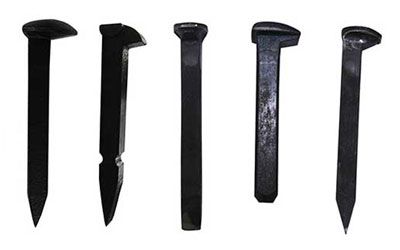Railroad spikes, also known as rail spikes or railroad nails, are large nails with a chisel point used to secure railroad rails to railroad ties (sleepers). They are an important part of the infrastructure that allows trains to run smoothly and safely across thousands of miles of railroad track.
Page Contents
History of Railroad Spikes
Railroad spikes have been used since the birth of rail transportation in the early 19th century. As rail networks expanded rapidly in the United States and Europe, large quantities of spikes were needed to build the tracks. The earliest spikes were made of cast iron, but various steel alloys soon replaced iron as the predominant material as they provided greater strength and durability.
In the late 19th and early 20th centuries, massive steel mills like Carnegie Steel mass produced railroad spikes by the millions. Standardization of railroad gauges and patterns allowed spikes to be mass produced in huge quantities with consistent sizes and shapes. Even with the decline in railroad usage after World War 2, millions of new spikes are still produced each year for maintenance and expansion of railroad networks.
Grades of Steel
Modern railroad spikes are made from medium carbon, high strength steel for optimal toughness, durability, and resistance to wear and bending under load. Most spikes are made from steel rod rolled into the right shape, then heat treated to achieve the desired hardness and strength.
There are several widely used standard grades of steel used for railroad spikes:
- ASTM A711 Grade C – This is a medium carbon steel with about 0.55-0.75% carbon content. It is heat treated to achieve a tensile strength of around 70,000 psi.
- ASTM A499 Grade 60 – A medium carbon steel with about 0.60% carbon and tensile strength of around 60,000 psi.
- ASTM A576 Grade 1060 – A medium carbon steel with 0.60% carbon and a minimum tensile strength of 100,000 psi.
- ASTM A510 Grade 1060 – Similar to ASTM A576 with a tensile strength of 100,000 psi.
Higher grades like ASTM A576 1060 and A510 1060 provide the highest strength but are more expensive. Lower grades like A711 and A499 are more economical but provide adequate strength for most general railroad applications.
Manufacturing Process
Railroad spikes are manufactured from steel rod rolled to the required shape on special rolling machines. The steps are:
- Steel rod of the desired grade is cut to length based on the spike design.
- The rods are heated to very high temperatures over 1600°F.
- After heating, the red hot rods are rolled between special die tools at high pressure to form the spike shape.
- After rolling, the formed spikes are cooled by quenching in water or oil to harden the steel.
- The cooled spikes may be tempered by reheating to a lower temperature to reduce brittleness and prevent cracking.
- Finally, the finished spikes are often galvanized by hot dipping into molten zinc to improve corrosion resistance.
Rolling provides excellent longitudinal strength while quenching and tempering creates the desired hardness and durability of the steel. Galvanizing helps prevent rusting in wet railroad environments.
Uses and Specifications
Railroad spikes are driven into wooden or composite ties to hold and secure the steel rails in the correct position and alignment. The chisel point focuses the force from hammer blows down into the tie without bending or mushrooming the top of the spike.
Different sizes and designs are used in various track locations:
- Standard track spikes – 5/16 to 3/4 inch diameter, 5-6 inch length
- Switch and bridge spikes – Similar but slightly larger sizes
- Screw spikes – Threaded for use in concrete ties
- Tap spikes – For tapping through holes in metal bridge ties
Newer tie designs like concrete and steel use special spikes or clips instead of standard wood spikes. Stainless steels offer better corrosion resistance in some environments.
| Spike Design | Length | Diameter | Minimum Tensile Strength |
|---|---|---|---|
| Standard | 5 – 6 inches | 5/16 – 3/4 inch | 60,000 psi |
| Switch/Bridge | 6 – 8 inches | 3/8 – 7/8 inch | 80,000 psi |
| Screw | 6 – 8 inches | 3/8 – 5/8 inch | 60,000 psi |
Higher strength spikes meet specifications like ASTM A576 1060 to minimize bending, wear, and failure.
Conclusion
In summary, modern railroad spikes are made from medium carbon steel grades like ASTM A711 Grade C, A499 Grade 60, A576 Grade 1060, and A510 Grade 1060. These steels offer an optimal combination of strength, toughness, and economical production. Manufacturing processes like hot rolling, quenching, and tempering produce strong spikes able to withstand heavy loads from trains passing over them. Quality spikes help ensure smooth, reliable, and safe operation of railroad networks.
